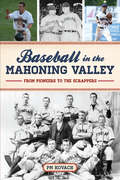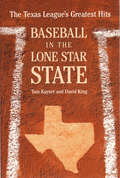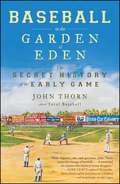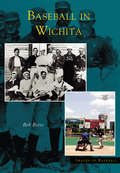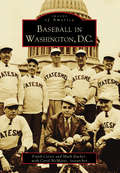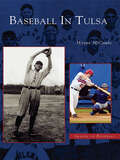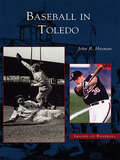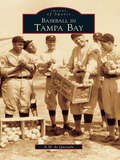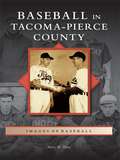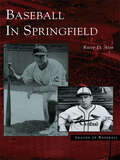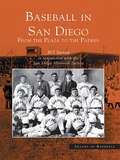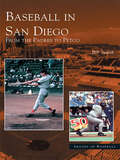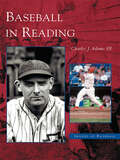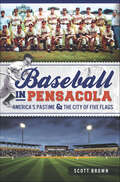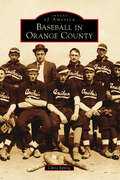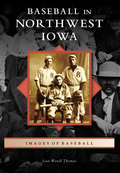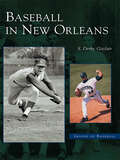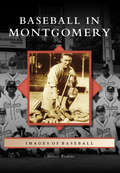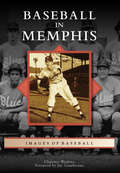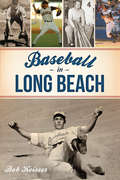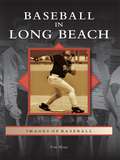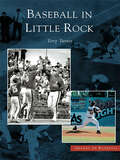- Table View
- List View
Baseball in the Mahoning Valley: From Pioneers to the Scrappers (Sports)
by Paul M. KovachAround the horn in the Mahoning Valley The history of baseball in Ohio's Mahoning Valley has been, to say the least, eventful. Murder, the Civil War, the hot dog, a presidential assassination and one of the deadliest known volcanic eruptions all shaped America's pastime in the Valley. African American baseball pioneer and Hall of Fame inductee Bud Fowler began his professional baseball career in the area, and the first ceremonial celebrity first pitch came from the arm of a prominent local. The area also contributed to Cleveland professional ballclubs like the enigmatic 1883 Blues and the 2016 Believeland Indians, which included numerous players from the Mahoning Valley Scrappers, a minor-league team with its own rich heritage. Digging up little-known facts about Fowler and sundry other colorful stories, local author and creator of Eastwood Field's Days Gone By exhibit PM Kovach celebrates the proud history of baseball in northeast Ohio.
Baseball in the Lone Star State
by David King Tom KayserIn short episodic chapters, Kayser and King create a history of this storied minor league, providing a broad picture of the shifting character of baseball operations over the past century or so. Portrayed are the many and varied and often colorful owners, managers, and players who did so much to give this league a powerful place in Texas culture.Accompanying the text are dozens of B&W photos, dating to the founding of the league, and an appendix of baseball statistics, essential information for the true aficionado.With nine teams in states from Arkansas, Texas, and Oklahoma, the Texas League has brought America's favorite sport to local fans for more than 100 summers. This book chronicles those games, their players, and will delight the legions of diehard fans of teams like the San Antonio Missions or El Paso Diablos or the Midland Rock Hounds who devotedly cheer loudly and boo lustily.
Baseball in the Lone Star State
by David King Tom KayserIn short episodic chapters, Kayser and King create a history of this storied minor league, providing a broad picture of the shifting character of baseball operations over the past century or so. Portrayed are the many and varied and often colorful owners, managers, and players who did so much to give this league a powerful place in Texas culture.Accompanying the text are dozens of B&W photos, dating to the founding of the league, and an appendix of baseball statistics, essential information for the true aficionado.With nine teams in states from Arkansas, Texas, and Oklahoma, the Texas League has brought America's favorite sport to local fans for more than 100 summers. This book chronicles those games, their players, and will delight the legions of diehard fans of teams like the San Antonio Missions or El Paso Diablos or the Midland Rock Hounds who devotedly cheer loudly and boo lustily.
Baseball in the Lone Star State
by David King Tom KayserIn short episodic chapters, Kayser and King create a history of this storied minor league, providing a broad picture of the shifting character of baseball operations over the past century or so. Portrayed are the many and varied and often colorful owners, managers, and players who did so much to give this league a powerful place in Texas culture.Accompanying the text are dozens of B&W photos, dating to the founding of the league, and an appendix of baseball statistics, essential information for the true aficionado.With nine teams in states from Arkansas, Texas, and Oklahoma, the Texas League has brought America's favorite sport to local fans for more than 100 summers. This book chronicles those games, their players, and will delight the legions of diehard fans of teams like the San Antonio Missions or El Paso Diablos or the Midland Rock Hounds who devotedly cheer loudly and boo lustily.
Baseball in the Garden of Eden: The Secret History of the Early Game
by John ThornThink you know how the game of baseball began? Think again. Forget Abner Doubleday and Cooperstown. Forget Alexander Joy Cartwright and the New York Knickerbockers. Instead, meet Daniel Lucius Adams, William Rufus Wheaton, and Louis Fenn Wadsworth, each of whom has a stronger claim to baseball paternity than Doubleday or Cartwright. But did baseball even have a father--or did it just evolve from other bat-and-ball games? John Thorn, baseball's preeminent historian, examines the creation story of the game and finds it all to be a gigantic lie, not only the Doubleday legend, so long recognized with a wink and a nudge. From its earliest days baseball was a vehicle for gambling (much like cricket, a far more popular game in early America), a proxy form of class warfare, infused with racism as was the larger society, invigorated if ultimately corrupted by gamblers, hustlers, and shady entrepreneurs. Thorn traces the rise of the New York version of the game over other variations popular in Massachusetts and Philadelphia. He shows how the sport's increasing popularity in the early decades of the nineteenth century mirrored the migration of young men from farms and small towns to cities, especially New York. And he charts the rise of secret professionalism and the origin of the notorious "reserve clause," essential innovations for gamblers and capitalists. No matter how much you know about the history of baseball, you will find something new in every chapter. Thorn also introduces us to a host of early baseball stars who helped to drive the tremendous popularity and growth of the game in the post-Civil War era: Jim Creighton, perhaps the first true professional player; Candy Cummings, the pitcher who claimed to have invented the curveball; Albert Spalding, the ballplayer who would grow rich from the game and shape its creation myth; Hall of Fame brothers George and Harry Wright; Cap Anson, the first man to record three thousand hits and a virulent racist; and many others. Add bluff, bluster, and bravado, and toss in an illicit romance, an unknown son, a lost ball club, an epidemic scare, and you have a baseball detective story like none ever written. Thorn shows how a small religious cult became instrumental in the commission that was established to determine the origins of the game and why the selection of Abner Doubleday as baseball's father was as strangely logical as it was patently absurd. Entertaining from the first page to the last, Baseball in the Garden of Eden is a tale of good and evil, and the snake proves the most interesting character. It is full of heroes, scoundrels, and dupes; it contains more scandal by far than the 1919 Black Sox World Series fix. More than a history of the game, Baseball in the Garden of Eden tells the story of nineteenth-century America, a land of opportunity and limitation, of glory and greed--all present in the wondrous alloy that is our nation and its pastime.
Baseball in the Barrios
by Henry HorensteinJoin nine-year-old Hubaldo Romero Páez in Venezuela as he introduces his friends, his family, and his favorite sport -- baseball. Complemented by a map and an English-Spanish baseball glossary, Hubaldo's story is an inviting introduction to a foreign land viewed through the lens of a shared passion.
Baseball in Wichita (Images of Baseball)
by Bob RivesThe art of baseball is evident at Wichita State University's Eck Stadium. The bronze sculpture, "Put Me in Coach," overlooks the stadium entry. Behind it a 70-foot mural, the longest of its kind at any university ballpark, depicts WSU's storied baseball history. The art of baseball has also been evident on Wichita's playing fields for well over a century. During and after the Civil War, baseball quickly spread across the nation. When Wichita was incorporated in 1870, the town and the game were ready for each other, and Wichita had its first professional nine the following decade. Baseball in Wichita tells the story of local baseball at all levels-amateur, collegiate and pro-in words and images dating from the 19th century to the present day.
Baseball in Washington, D.C. (Images of America)
by Frank Ceresi Mark Rucker Carol McmainesDubbed "America's Game" by Walt Whitman, baseball has been enjoyed in our nation's capital by everyone from young boys playing street stickball to Presidents throwing out the inaugural first pitch of the season. Just 13 years after Alexander Cartwright codified baseball's rules, the Washington Nationals Baseball Club formed and in 1867 toured the country spreading the "baseball gospel." By 1901 the team became one of the first eight major league teams in the newly formed American League. Players such as Walter Johnson, probably the greatest pitcher of all time, and other Senators under the stewardship of owner Clark Griffith successfully led the club in 1924 to what many consider to be the most exciting World Series in baseball history.Later, the Homestead Grays played at Griffith Stadium and fielded a team featuring legendary Negro League greats such as Josh Gibson and Buck Leonard. The powerhouse Grays, during a ten-year span, won nine Negro League World Championships, a record that may never be equaled in any team sport again.When the Grays disbanded, the original Senators left for Minnesota in 1960, and the expansion Senators of the 1960s relocated, the city was left without a professional baseball team. While many feared that baseball in D.C. was over, a spirit remained on the diamond and is still felt today as children and adults team up in one way or another to play the national pastime in the nation's capital. Hopes for a new professional team linger, and those remembering baseball's heyday will enjoy this extensive and unusual collection ofhistoric photos that celebrate a time when the crowds roared and Washingtonians believed that the summer game would never end.
Baseball in Tulsa (Images of Baseball)
by Wayne MccombsThe rich tradition and history of professional baseball are brought to life in Baseball in Tulsa. Wayne McCombs traces Tulsa's baseball past from the cow pastures of Indian Territory into the 21st century. The book documents the struggle many players endure in the coveted quest to become a major league baseball player. Showcasing a collection of over 170 rare photographs, this new volume vividly documents the sport that makes Tulsa one of the best minor league cities in America. See all the greats from the original Tulsa Oilers through today's Tulsa Drillers, including hall-of-famers Satchel Paige, Frank Robinson, Steve Carlton, Dizzy Dean, and Warren Spahn-each of these legends either played or coached in Tulsa.
Baseball in Toledo (Images of Baseball)
by John R. HusmanProfessional baseball teams in Toledo, Ohio, were first known as the Mud Hens-for the local marsh birds-more than a century ago. About a dozen other team names have been used over the course of 106 seasons dating back to the first in 1883. The city has been represented in minor leagues of various levels, the Negro leagues, and the major leagues as well. For most of the last 100 years, Toledo teams have played at the highest minor league classification. Many associated with Toledo baseball have gone on to successful major league careers as players, managers, and umpires. Fifteen have been enshrined in the National Baseball Hall of Fame and others hold numerous major league records.Baseball in Toledo traces the long and rich Toledo baseball history through pictures drawn from several major collections, along with detailed captions. Included is a summary of every Toledo season, and an all-time Toledo roster that lists all the players ever to wear a Toledo uniform.
Baseball in Tampa Bay (Images of Sports)
by A.M. de QuesadaTampa Bay's interest in baseball spans from the sport's earliest days to the region's win of a national league franchise in the last decade of the 20th century. Hosting more major league spring training games than any other region inthe United States, Tampa has been home to a number of springtraining camps, for teams including the Chicago Cubs and the Washington Senators. St. Petersburg has played host for the Philadelphia Phillies and the Baltimore Orioles, among others. Not only does this region have a rich professional baseball history, but a thriving Little League and recreational leaguetradition. Stars, both young and old, have played for these teams and have brought glory to their hometown. Both St. Petersburg and Tampa formed their own local teams when the minor league was created in 1919, but Tampa Bay's dream for a major league team of its own finally came true in 1995, when, at a meeting of baseball owners in West Palm Beach, the Tampa Bay Devil Rays became the thirteenth expansionteam in major league history.
Baseball in Tacoma-Pierce County (Images of Baseball)
by Marc H. BlauThe Tacoma-Pierce County area has enjoyed a rich tradition of baseball from the sandlot beginnings in 1874, to the first professional game at the "Eleventh Street Ball Grounds" in 1890, to the "100 Day Wonder" known as Cheney Stadium, which was opened in the spring of 1960. While Tacoma has laid claim to six Pacific Coast League championships since the 1904-1905 season, it was the players who competed in the City, Valley, Sunset, Community, Timber, Commercial, Industrial, and Shipbuilders leagues that formed the backbone of the sport. Among notables that have dotted local rosters or competed in the major leagues are Ron Cey, "Indian" Bob Johnson, Mike Blowers, Jon Lester, Steve Whitaker, and Doug Sisk, as well as Baseball Hall of Famers Walter Johnson, Joe McGinnity, Juan Marichal, Gaylord Perry, and Willie McCovey.
Baseball in Springfield (Images of Baseball)
by Rusty D. AtonIt has been more than half a century since Springfield last hosted minor league baseball. That draught will end at downtown's newly constructed Hammons Field in the spring of 2005, when the Springfield Cardinals of the AA Texas League bring professional baseball back to the Queen City of the Ozarks. The new team will have quite a legacy to fulfill, as the Springfield Cardinals of the Western Association won several pennants those many years ago, and brought to town such legendary baseball names as Branch Rickey, Joe Garagiola, and Stan Musial. Before the Cardinals came teams like the Midgets, Reds, and Merchants, and a rich tradition of professional and semi-pro baseball dating back to the mid-1880s. Drawing from a wide range of primary sources and complimented by over 100 vintage images, Baseball in Springfield is must-have for those ready to discover the historic connection this city has to the national pastime.
Baseball in San Diego: From the Plaza to the Padres (Images of Baseball)
by Bill Swank San Diego Historical SocietyBaseball in San Diego: From the Plaza to the Padres, takes the reader on a seven-decade journey from Horton Plaza, the site of San Diego's first base ball game in 1871, to lower Broadway and the future home of Lane Field. Before the Pacific Coast League, San Diego had three Class D teams. One was the Bears, whose frustrated owner Dick Cooley complained, "I don't believe they'll make baseball pay here in a thousand years." With America's finest year-round climate, barnstorming and black baseball were popular attractions. Rube Foster's Chicago American Giants practically lived in San Diego in the winter of 1913. All the while, there were constant struggles between the forces of amateur and professional baseball for players, diamonds, and sports coverage.
Baseball in San Diego: From the Padres to Petco (Images of Baseball)
by Bill SwankThe first color action photo of Ted Williams (as shown on the front cover) was taken at Lane Field in San Diego on October 5, 1941 by an amateur photographer. Nobody knew of its existence until an old wooden cigar box was found in a basement in 1999. This book is a treasure chest of such old San Diego baseball pictures and memories. From the Padres to Petco focuses on San Diego's love affair with the Padres from the Pacific Coast League years at Lane Field (1936-57), Westgate Park (1958-67), San Diego Stadium (1968) and through 35 more exciting and often exasperating National League summers in Mission Valley (1969-2003). Through it all, Padre fans have been faithful and forgiving. With a new ballpark, San Diego looks to build a winning tradition.
Baseball in Reading (Images of Baseball)
by Charles J. Adams IIIOn a crisp April evening or a sizzling August afternoon, before a handful of friends or a throng of thousands, on a playground sandlot or in one of America's storied minor-league stadiums-whenever and wherever baseball is played in Reading, Pennsylvania, it is played with passion.Baseball in Reading captures for the first time the images of the teams, players, and ballparks that have made the city one of minor-league baseball's true legends. Claiming the title Baseballtown in 2002, Reading has a baseball legacy that dates back to the late 1800s. Only three other minor-league teams have remained in the same location for a longer period of time. Players such as Charlie Wagner, Roger Maris, and Rico Petrocelli have contributed to the rich history that unfolds in Baseball in Reading.
Baseball in Pensacola: America's Pastime & the City of Five Flags (Sports)
by Scott BrownThe Western Gate to the Sunshine State boasts an epic history of hardball, dating back nearly to the beginning of the sport. Sunshine, loyal fans and pristine beaches have attracted baseball's best athletes to Pensacola--from stars like Babe Ruth and Ted Williams to the Blue Wahoos, modern-day affiliate for the Cincinnati Reds. The city is home to major-league teams during spring training, minor-league teams during the season and baseball fanatics year-round. Whether it's following big-league icons or cheering high school future stars, Pensacola's love affair with baseball runs deep. Team up with local author Scott Brown as he details the area's greatest moments in America's oldest pastime.
Baseball in Orange County (Images of America)
by Chris EptingOrganized baseball in Orange County began in the late 1880s when community teams began forming among oil well workers. Around 1900, a farm boy from Kansas named Walter Johnson arrived with his family. Soon, the flame-throwing future hall-of-fame pitcher would be dominating games throughout the county as a star for Fullerton Union High School. As the popularity of baseball grew, more teams and leagues formed in Santa Ana, Anaheim, Huntington Beach, and other cities. Connie Mack brought the Philadelphia Athletics to spring train in Orange County in the 1940s. Joe DiMaggio played for his Santa Ana Air Base team after joining the Army. Babe Ruth, Lou Gehrig, Jackie Robinson, and many other legends visited Orange County over the years. Dozens of well-known players grew up here, and many are laid to rest here. In 1966, the California Angels played their first game in Orange County, where they remain today as the Los Angeles Angels of Anaheim. The baseball history in Orange County is rich--and surprising.
Baseball in Northwest Iowa (Images of Baseball)
by Joan Wendl ThomasWhile new railroad tracks cut through Northwestern Iowa in the mid-19th century, hardy pioneers cultivated the fertile soil, and the burgeoning sport of baseball took root and flourished. An integral element of the developing culture, it promoted community pride. Eight Northwestern Iowa towns supported professional teams by 1912, the first being Sioux City in 1888. Over time, that city’s clubs produced hall-of-fame shortstop Dave Bancroft and initiated the still-existing American League. Homegrown talent from an abundance of professional, semiprofessional, and amateur clubs throughout the area’s 19 counties yielded 38 major-league players before 1960 and more since.
Baseball in New Orleans (Images of Baseball)
by S. Derby GisclairIn July of 1859, seventy-five young New Orleanians came together to form the seven teams that comprised the Louisiana Base Ball Club. They played their games in the fields of the de la Chaise estate on the outskirts of New Orleans near present-day Louisiana Avenue. As America's population grew through immigration, so did the popularity of what the largest newspaper in New Orleans, the Daily Picayune, called in November of 1860 "the National Game." Baseball quickly replaced cricket as the city's most popular participant sport.In 1887, local businessmen and promoters secured a minor league franchise for the city of New Orleans in the newly formed Southern League, beginning the city's 73-year love affair with the New Orleans Pelicans. From Shoeless Joe Jackson, to Hall of Famers Dazzy Vance, Joe Sewell, Bob Lemon, and Earl Weaver, to today's stars such as Jeff Cirillo and Lance Berkman, the road to the majors brought many notable players through New Orleans. From these early beginnings to the present-day New Orleans Zephyrs of the AAA Pacific Coast League, local fans have continued the tradition of baseball in New Orleans.
Baseball in Montgomery (Images of Baseball)
by Clarence WatkinsIn 2004, Riverwalk Stadium ushered in a new era of professional baseball in Montgomery. After a more-than-20-year absence, the new ballpark became a catalyst for the revitalization of downtown Montgomery. Biscuit baseball and Riverwalk Stadium have given citizens something to be proud of. The stadium is nestled between the Alabama River and railroad tracks and incorporates the old Western Railroad building as part of the ballpark. This has made Riverwalk an example for other cities looking to keep their identity and add something new and exciting. Montgomery’s rich baseball history includes hall of fame players like Fred Clarke, Joe McGinnity, Casey Stengel, and Turkey Stearnes. There is also the forgotten history of an Alabama native, Roy “Goat” Walker, a fan favorite of Montgomery baseball for two generations.
Baseball in Memphis (Images of Baseball)
by Clarence Watkins Jay GauthreauxAuto Zone Park, arguably the best minor-league baseball park built in the past 25 years, is nestled in a corner of downtown Memphis. Located across the street from the historic Peabody Hotel and two blocks from Beale Street, Auto Zone opened in 2000 to rave reviews. It is the phoenix that rose from the ashes of Russwood Park. Baseball enthusiasts remember Russwood and the players who roamed the field, like Dazzy Vance, one-arm Pete Gray, Big Klu, and Moonlight Graham. Images of Baseball: Baseball in Memphis highlights the history of the Chicks and the Redbirds and pays homage to the original amateur Chickasaws, the Red Sox, and the Blues.
Baseball in Long Beach (Sports)
by Bob KeisserMore than two hundred Major League Baseball players have hailed from Long Beach and its suburbs. This hotbed of horsehide heroics includes Hall of Famers Bob Lemon, Duke Snider and Tony Gwynn, as well as longtime stars Ron Fairly, Bob Bailey, Bobby Grich, Chase Utley and Jered Weaver. Negro League and Pacific Coast League clubs enjoyed Long Beach connections. Many players whose cleats tore up legendary Rec Park and Blair Field are enshrined in the city's baseball/softball hall of fame. The winning tradition continues as Long Beach State's "Dirtbags" sent more players to the bigs in 2010 and 2011 than any other college. Join baseball historian Bob Keisser as he recounts Long Beach's greatest baseball stars, teams and stories.
Baseball in Long Beach (Images of Baseball)
by Tom MeigsOrganized baseball in Long Beach dates to 1910, whenthe Long Beach Clothiers of the Southern CaliforniaTrolley League played opponents wherever a streetcar could take them. Exhibition games later featured Babe Ruth, Lou Gehrig, Joe DiMaggio, Bob Feller, and other Major League barnstormers. Homegrown talent includes Baseball Hall of Famers Bob Lemon and Tony Gwynn. Pioneering entrepreneur Bill Feistner built the first accommodating baseball park in 1922 at Redondo Avenue and Stearns Street in the shadow of oil-rich Signal Hill. When ballplayers weren't on the Shell Park diamond, they worked the derricks.
Baseball in Little Rock (Images of Baseball)
by Terry TurnerProfessional baseball in Little Rock dates back to 1895. Fans in Arkansas' capital city have been entertained by Travelers' baseball for parts of three centuries. Using only one team name and playing on just two home fields, the Travelers have displayed stability unique in minor league baseball. The team is fan owned, another rarity in professional sports. Baseball in Little Rock follows the team's long diamond history, from the struggles of the Southern Association through the triumphs of the Texas League.
